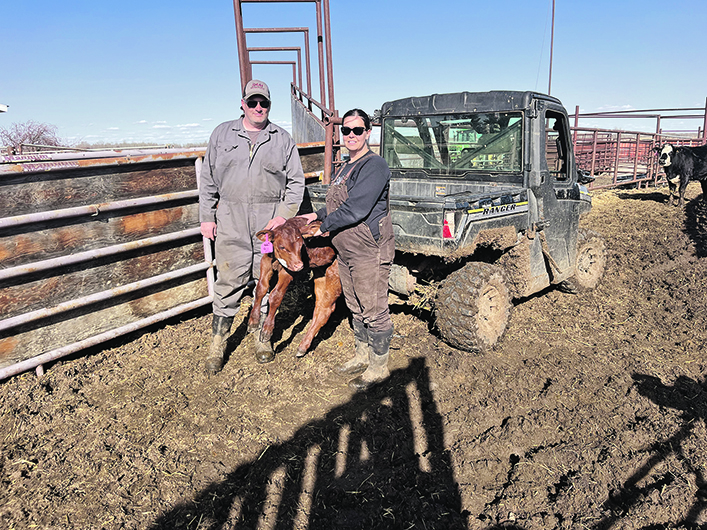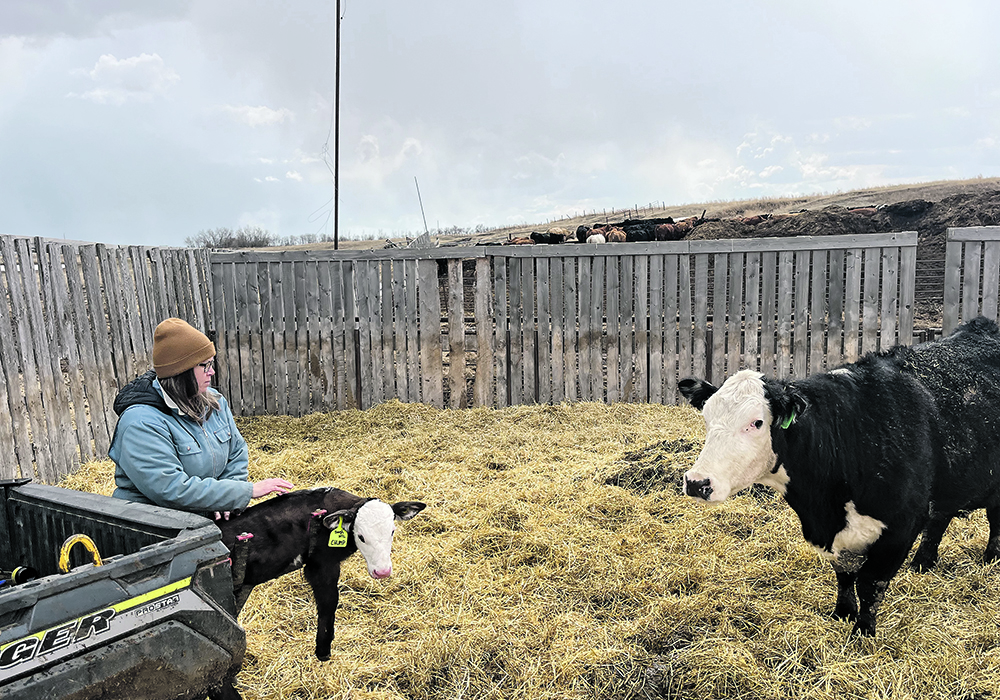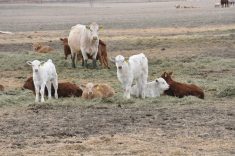Newborn calves massaged for one minute needed fewer health treatments in the first 30 days and were heavier at weaning
Karyn and Lance Neilsen take a hands-on approach to their animals at calving time, and the newborn calves’ experience with the “spa” massage treatment appears to be paying off.
The Neilsens of Stettler, Alta., are part of a three-year study with Olds College to assess the effect of tactile stimulation in newborn calves. A gentle rubbing is thought to mimic maternal stimulation such as licking or grooming.
“It’s like petting a dog,” said Karyn, who completes each one-minute massage while Lance keeps track on his stopwatch.
“I start at the top of their head and ears and work my way down their body, legs and back end with firm but steady pressure.
“Lots of times they are resistant for the first 10 to 15 seconds, but then they actually settle into it and realize they like it. Lots of times, by the end, their tail is wagging quite happily,” she said.
The project is headed by Dr. Désirée Gellatly, a research scientist at the Olds College Technology Access Centre for Livestock Production. She first saw the benefits of hands-on massage in her native Brazil as part of a research group studying ways to improve productivity, health and welfare in Zebu dairy calves.
The Zebu breed is characterized by a fatty hump on the shoulders, a large dewlap and sometimes drooping ears. They tend to be more aggressive and excitable compared to the common cattle breeds of North America and Europe.
“I have been captivated by the idea of how simply improving the welfare of farm animals can significantly enhance the profitability of the livestock industry,” said Gellatly.
“The main goal is to reduce the animals’ stress levels during future handling occasions and subsequently improve their immune response as well as growth and reproductive performance,” she said.
“Can we improve the temperament of those animals from the day they are born? Can we start doing any strategy to actually change how they permanently perceive humans?”
Besides cleaning, a cow’s licking behaviour warms the calf and creates a bond. By stimulating nerve receptors in the skin, the process provides what appears to be a pleasant sensation for the calf.
Early and positive sensory interactions lower secretion of stress hormones, which lowers the fight-or-flight response in adulthood. These changes are permanent, Gellatly said.
“The most sensitive period of brain development in calves is in the first week. We recommend immediately after processing the calves to apply gentle but firm pressure with your hands around the legs, back and areas that the cow would lick,” she said.
Some argue that procedures such as tactile stimulation are unnecessary for beef calves because they receive positive stimulation from their mothers through the cow’s lick.
However, the goal is to use this period in the calf’s brain development to the handler’s advantage. “Unfortunately, this window is often overlooked, and interactions with humans are either negative or nonexistent, considering some producers only process their calves a few months after birth. This is often because of the mistaken belief that not interacting with the animals at all will reduce their stress levels.
“In reality, given our current understanding of the importance of this critical period, such approaches (negative or non-interaction) could ultimately be detrimental to achieving optimal results,” she said.
Karyn Neilsen has seen positive results from her part in the study.
“I think the massage lowers their cortisol levels. So when they are around humans they’ve had that synapse in their brain that we’re not scary and they’re going to be calmer because they’ve had more touch.”
Most cows don’t seem to mind either, she said.
“The mother is usually right there. Most of our cows are very quiet and calm even after they’ve just calved. They’ll just stand and watch. Sometimes, they get a little upset and we have to chase them back a little bit. But most often they just wait while we finish up with the calf.”
All 220 of Neilsens’ calves are weighed, tagged and given selenium and vitamin A and D between 24 and 48 hours after birth. Bull calves are also banded.
As part of the study, half the newborns are given a one minute massage after processing at one day of age and the other half receive no massage.

“We found animals that received this one-minute massage had 20 percent less incidence of health treatments in the first 30 days and were 47 pounds heavier prior to weaning compared with animals that did not receive the massage,” said Gellatly.
Lance Neilsen confirmed the superior weight gain in massaged calves.
“We saw quite significant improvements in weight gain (in heifers) while they were on their mother. The ones that were massaged were sick less often and gained weight better.
“We backgrounded them for another two months after weaning and followed their weight gains and their sickness events. And the same thing occurred post weaning.”
However, he saw no improved weight gain in steers, which he believed was tied to the pain of banding and castration.
“This year, we’re giving them a shot of lidocaine at the time we band them, so we’re going to see. We’re hoping this fall we’ll have a better weight gain on the steers to be more like the heifer weight gain,” he said.
The Neilsens are convinced that newborn massage benefits the health of their herd and their bottom line.
“I think it’s amazing. It’s an easy extra minute to spend with each calf for those benefits. Doesn’t cost anything. That’s an excellent return on investment,” said Karyn.
Lance agreed.
“It looks like calves are going to be three bucks a pound in the fall, so 47 times $3. That extra $150 is a lot of money per calf. We’re getting paid pretty well per minute there and not treating as much either. We had less pneumonias and stuff like that. So that also saves money.”


















